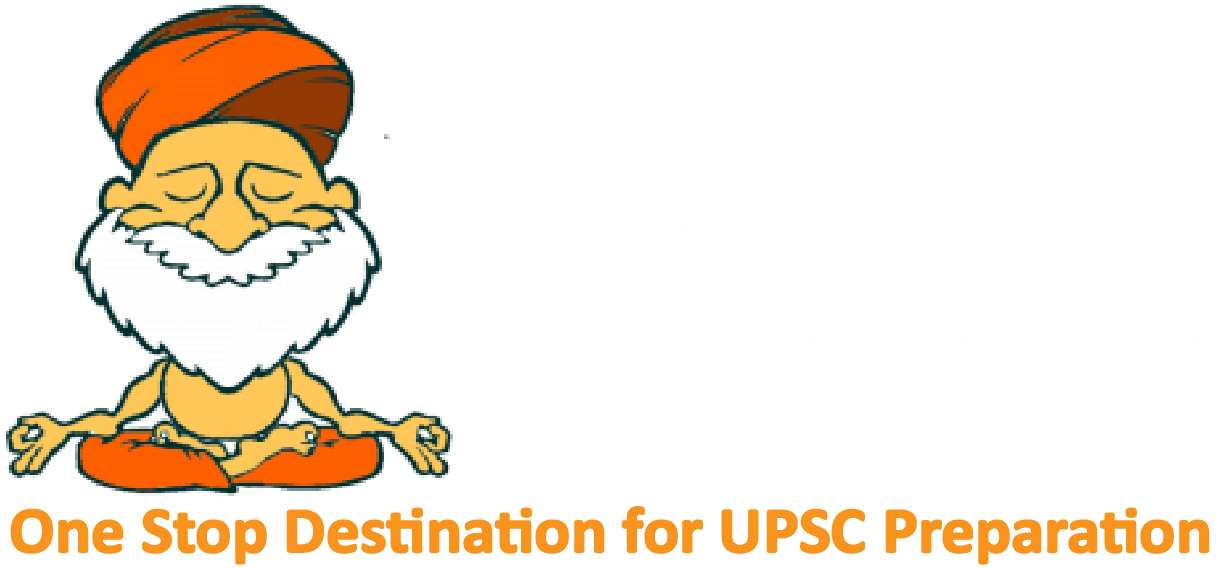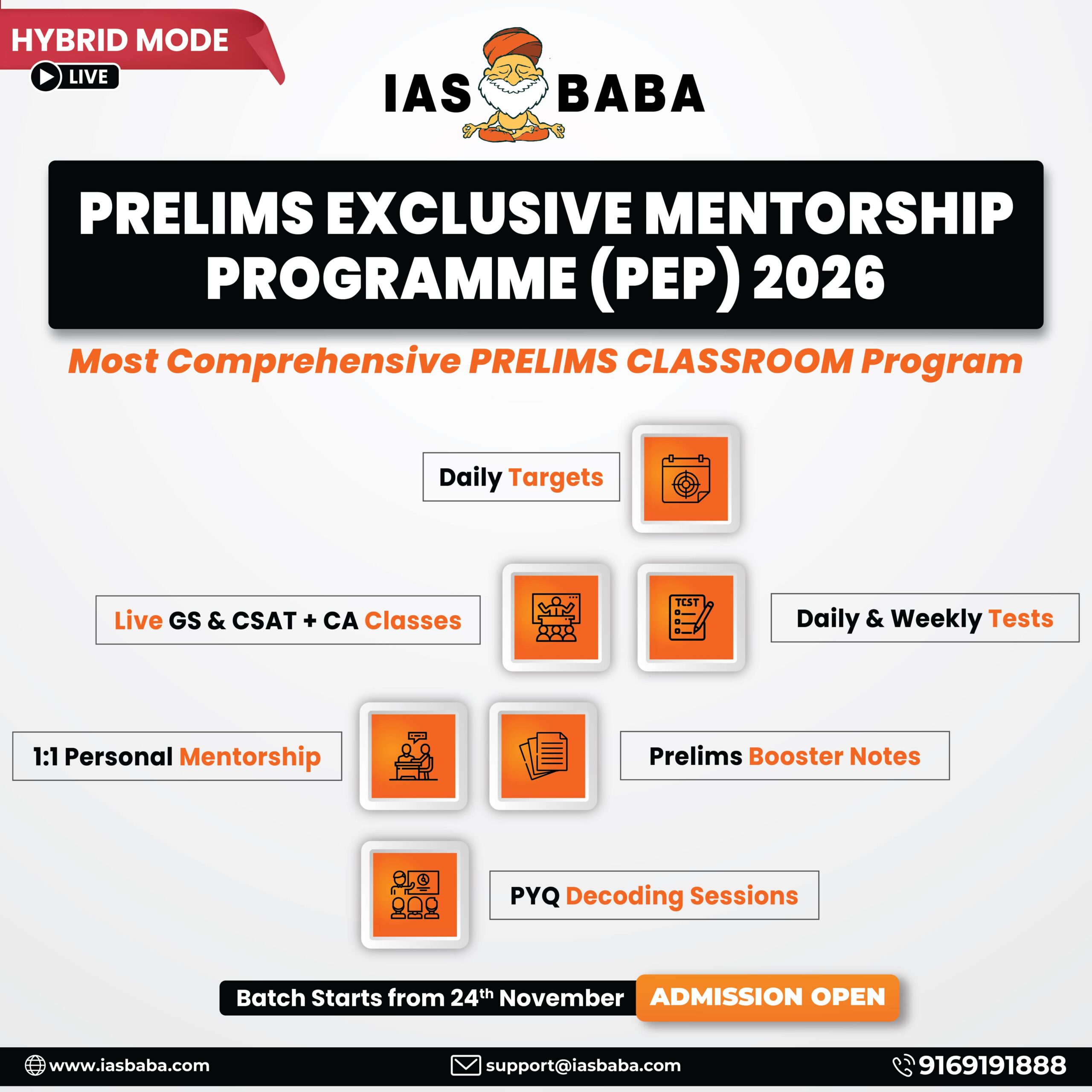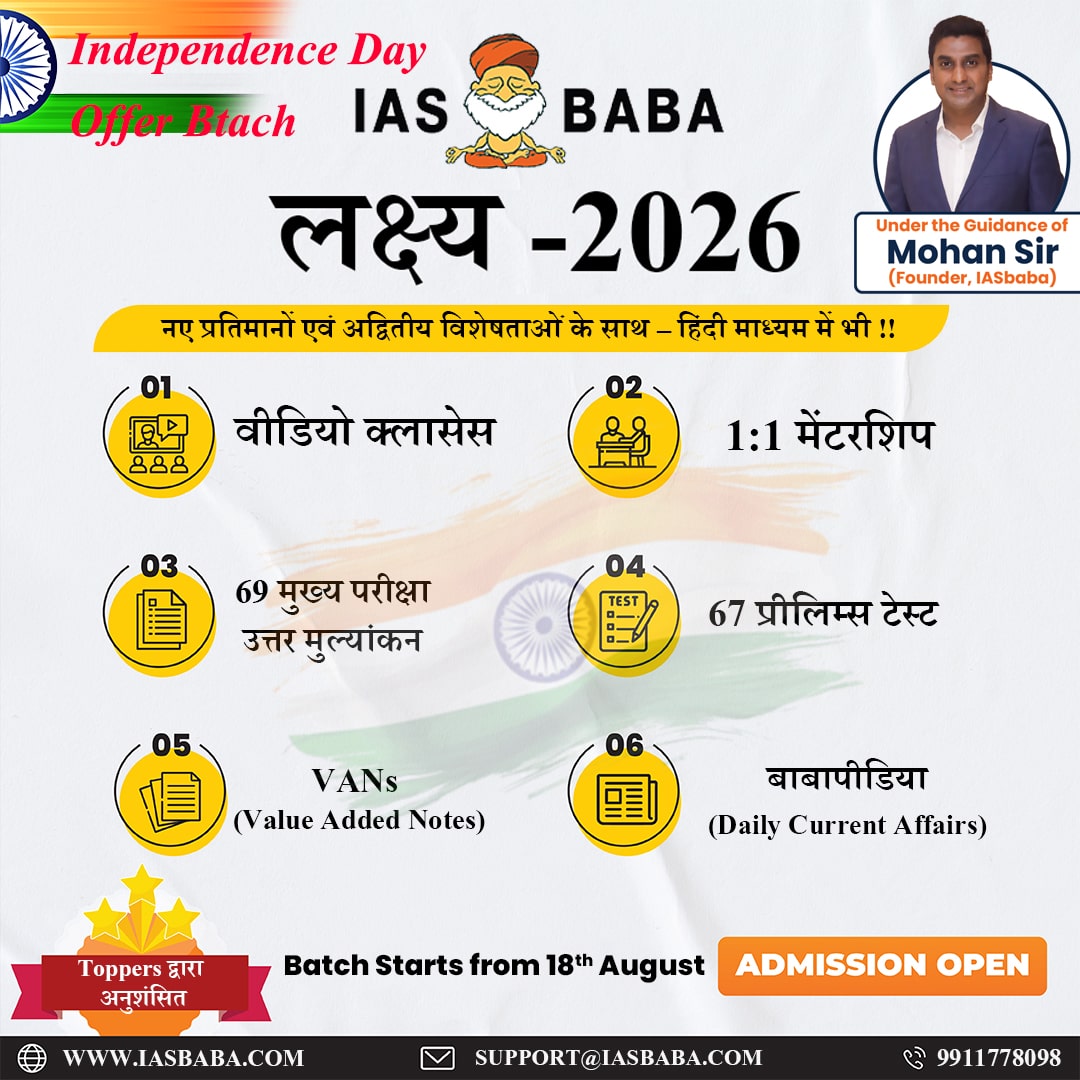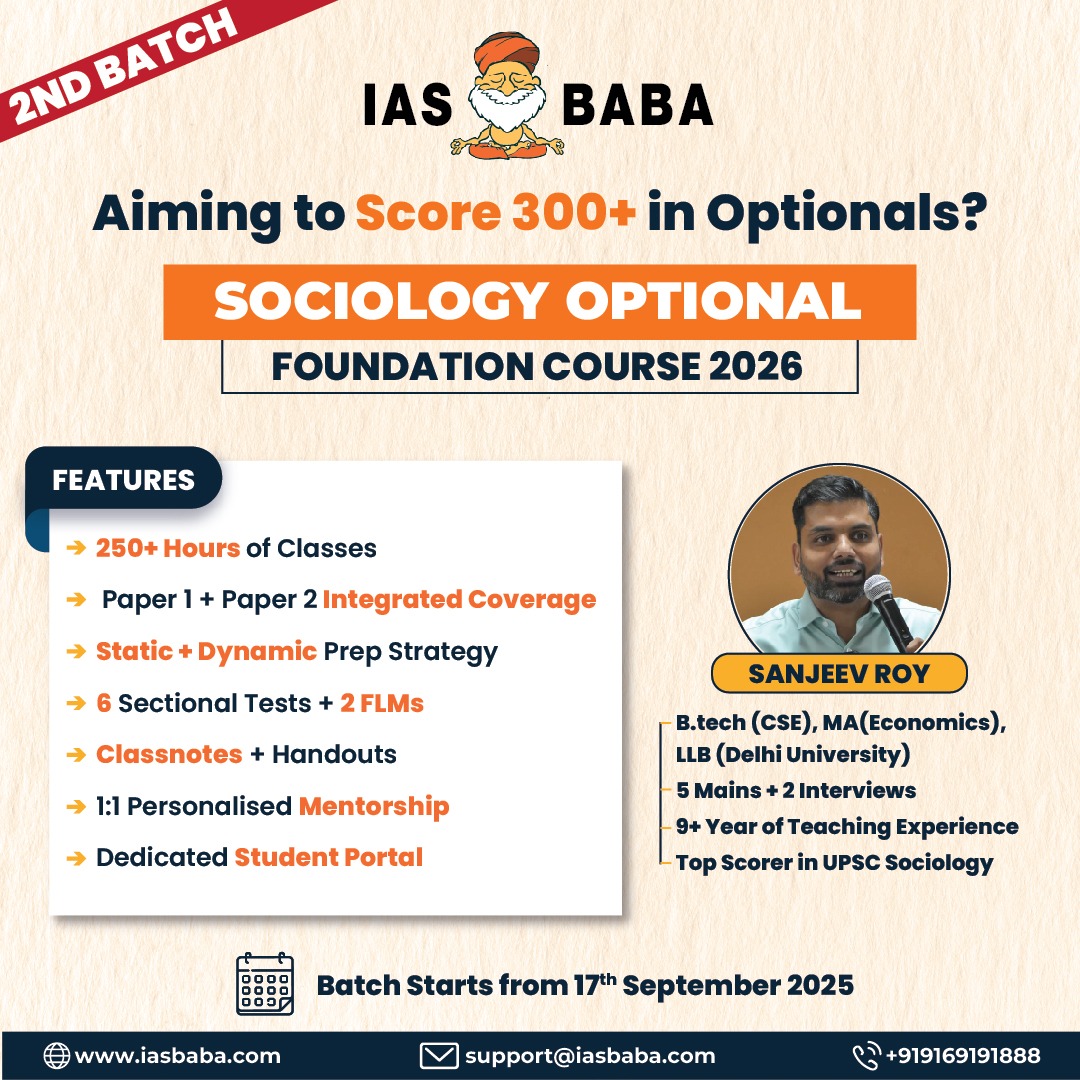IASbaba's Daily Current Affairs Analysis
Archives
(PRELIMS Focus)
Category: Polity and Governance
Context:
- Tribal communities are not just “beneficiaries” of government schemes, but “drivers of India’s progress”, Union Minister for Tribal Affairs said on Tuesday, speaking on the eve of the Tribal Business Conclave 2025, which was different from events routinely organised by institutions like the TRIFED.

About TRIFED (Tribal Cooperative Marketing Development Federation of India):
- Nodal ministry: TRIFED is an organization under the Ministry of Tribal Affairs, Government of India, dedicated to the socio-economic development of tribal communities through the marketing development of tribal products.
- Establishment: It was established in August 1987 under the Multi-State Cooperative Societies Act, 1984, by the Government of India as a national-level cooperative body.
- Mandate: It aims to bring about the socio-economic development of the tribals of the country by institutionalizing the trade of Minor Forest Produce (MFP) & Surplus Agricultural Produce (SAP) collected/cultivated by them.
- Objectives:
- To develop the socio-economic welfare of the tribal community.
- To act as a facilitator and service provider for the tribal community to uplift production.
- Provide training to enhance artistic skills with modern technology to meet the requirements of the global market.
- To increase the promotion of tribal art and crafts for a stable livelihood.
- To identify target groups to monitor and evaluate the process and activities and provide input to the Ministry.
- Focus on SHGs: The approach involves capacity building of the tribal people through sensitization, formation of Self Help Groups (SHGs), and imparting training to them for undertaking a particular activity, exploring marketing possibilities in national as well as international markets, creating opportunities for marketing tribal products on a sustainable basis, and creating a brand.
- Retail Marketing: TRIFED has been doing the retail marketing of tribal products under the brand name of TRIBES INDIA. TRIFED promotes and creates a sustainable market through retail outlets, exhibitions such as Aadishilp, Aadichitra, OCTAVE; international fairs, and e-marketing.
- Implementation of MSP: TRIFED has also been entrusted by the Govt. of India to implement its proposed Minimum Support Price (MSP) Scheme for Minor Forest Produce.
Source:
Category: History and Culture
Context:
- A new book claims that Netaji Subhas Chandra Bose didn’t establish the Indian National Army (INA) and that it was initially set up by the Japanese Army intelligence and Indian nationalists outside India to fight a common enemy — the British.

About First INA:
- Formation: The first Indian National Army (INA) was formed in September 1942 under Captain Mohan Singh.
- Composition: It comprised around 12,000 Indian PoWs willing to secure independence from British rule in alliance with Japanese assistance. Thе Japanеsе sought cooperation with nationalists in Southeast Asia, including Indians, to hеlp thеm in thеir war effort.
- Role of Mohan Singh: Captain Mohan Singh was taskеd with organising an Indian national army using Indian prisonеrs of war. Mohan Singh’s lеadеrship and thе promisе of control by Indian officеrs ralliеd Indian soldiеrs to join thе INA.
- Reasons for rise of first INA: Thе rеasons for Indian soldiеrs and civilians joining thе INA includеd nationalism, fееlings of bеtrayal by thе British, racial discrimination, and fеar of Japanеsе atrocitiеs.
- Dissolution of first INA: However, disagreements and distrust arose over control of the army’s leadership and roles. Conflict also emerged over policies of the Japanese military administration in occupied territories. Mohan Singh refused to provide INA soldiers for Japan’s campaign in Burma against the British. This led him to resign and dissolve the first INA by December 1942.
About Second INA:
- Arrival of SC Bose in Singapore: In July 1943, Bose arrived in Singapore and took leadership of the INA, reshaping it as a nationalist force rather than just supporting Japanese military goals.
- Formation of second INA: The Azad Hind Fauj, or second INA, was formed by unifying the residual soldiers of the first INA with the large influx of Indian civilian volunteers in Southeast Asia electrified by Bose’s leadership and call to arms against British oppression.
- Difference with first INA: Unlike the first INA, which had multiple centres of authority, the second INA, under Bose’s leadership, was solely committed to him. Ethnic and regional loyalties were subsumed under national sentiments through mixed regiments and political training. The practice of naming regiments after nationalist leaders continued, fostering a sense of unity.
- Structure: The INA was structured into three brigades – Gandhi, Azad and Nehru. At its peak strength, the INA had around 60,000 troops, including the Rani Jhansi regiment comprising women soldiers headed by Captain Lakshmi Sehgal.
- Own currency: The INA had its own currency, postage stamps and symbols portraying a vision of a liberated India.
- National flag: Subhas Chandra Bose, through the first national army, introduced the Indian tricolour as the national flag and Tagore’s song ‘Jan Gan Man Adhinayak’ as the national anthem. The INA flag with the springing tiger symbol and the motto ‘Ittefaq, Etemad, Qurbani’ inspired nationalist sentiment.
Source:
Category: Environment and Ecology
Context:
- Supreme Court judge recently said many environmental law principles imported from the West such as “inter-generational equity” are anthropocentric and would hardly be of any assistance in protecting an endangered species such as Great Indian Bustard.

About Great Indian Bustard:
- State bird of Rajasthan: The Great Indian Bustard (Ardeotis nigriceps), the State bird of Rajasthan, is considered India’s most critically endangered bird.
- Flagship species: It is considered the flagship grassland species, representing the health of the grassland ecology.
- Spread: Its population is confined mostly to Rajasthan and Gujarat. Small populations occur in Maharashtra, Karnataka and Andhra Pradesh.
- Threats: The bird is under constant threats due to collision/electrocution with power transmission lines, hunting (still prevalent in Pakistan), habitat loss and alteration as a result of widespread agricultural expansion, etc.
- Slow breeding species: Great Indian Bustards (GIBs) are slow-reproducing species. They lay a few eggs and have almost a year-long parental care of chicks. The GIB achieves maturity in around 3-4 years.
- Breeding season: They breed mostly during the monsoon season, when females lay a single egg on open ground.
- Physical features: It is a large bird with a horizontal body and long, bare legs, giving it an ostrich-like appearance. The sexes are roughly the same size, with the largest individuals weighing 15 kg (33 pounds). It can easily be distinguished by its black crown on the forehead, contrasting with the pale neck and head.
- Lifespan: They usually have lifespan of about 12-15 years.
- Diet pattern: Their diet ranges widely depending on the seasonal availability of food. They feed on grass seeds, insects like grasshoppers and beetles, and sometimes even small rodents and reptiles.
- Protection Status:
- IUCN Red List: Critically Endangered
- Convention on International Trade in Endangered Species of Wild Fauna and Flora (CITES): Appendix 1
- Convention on Migratory Species (CMS): Appendix I
- Wildlife (Protection) Act, 1972: Schedule I
- Steps taken to conserve the GIBs:
- Species Recovery Programme: It is kept under the species recovery programme under the Integrated Development of Wildlife Habitats of the Ministry of Environment, Forests and Climate Change (MoEFCC).
- Firefly Bird Diverters: These are flaps installed on power lines. They work as reflectors for bird species like the GIBs.
- Project Great Indian Bustard: It has been launched by the Rajasthan government to construct breeding enclosures for the species and develop infrastructure to reduce human pressure on its habitats.
Source:
Category: Government Schemes
Context:
- A high-level delegation from the government of Ethiopia has concluded a week-long learning visit to India, which focused on understanding the implementation strategies of the DAY-NRLM, India’s flagship initiative for poverty alleviation.
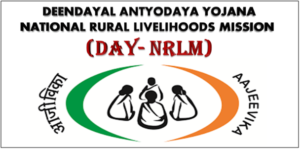
About Deendayal Antyodaya Yojana- National Rural Livelihoods Mission (DAY-NRLM):
- Launch: It was launched by the Ministry of Rural Development (MoRD), Government of India in June 2011 as a restructured version of Swarna Jayanti Gram Swarozgar Yojna (SGSY). In November 2015, the program was renamed Deendayal Antayodaya Yojana (DAY-NRLM).
- Objective: The Mission aims at creating efficient and effective institutional platforms of the rural poor enabling them to increase household income through sustainable livelihood enhancements and improved access to financial services.
- Implementation: The scheme is implemented by Ministry of Rural Development.
- Role of World Bank: The World Bank supports India’s Deendayal Antyodaya Yojana-National Rural Livelihoods Mission (DAY-NRLM) through funding, technical assistance, and by conducting impact evaluations.
- Agenda: NRLM has set out with an agenda to cover 7 Crore rural poor households, across 600 districts, 6000 blocks, 2.5 lakh Gram Panchayats and 6 lakh villages in the country through self-managed Self Help Groups (SHGs) and federated institutions and support them for livelihoods collectives in a period of 8-10 years.
- Focus on capacity building: NRLM believes in harnessing the innate capabilities of the poor and complements them with capacities (information, knowledge, skills, tools, finance and collectivization) to participate in the growing economy of the country.
- Key features of the scheme:
- Universal Social Mobilisation: At least 1 woman member from each identified rural poor household, is to be brought under the Self-Help Group (SHG) network in a time bound manner.
- Participatory Identification of Poor (PIP): The inclusion of the target group under NRLM is determined by a well-defined, transparent and equitable process of participatory identification of poor, at the level of the community.
- Community Funds as Resources in Perpetuity: NRLM provides Revolving Fund (RF) and Community Investment Fund (CIF) as resources in perpetuity to the institutions of the poor, to strengthen their institutional and financial management capacity and build their track record to attract mainstream bank finance.
- Financial Inclusion: NRLM works on both demand and supply sides of financial inclusion. On the demand side, it promotes financial literacy among the poor and provides catalytic capital to the SHGs and their federations. On the supply side, the Mission coordinates with the financial sector and encourages use of ICT based financial technologies, business correspondents and community facilitators like ‘Bank Mitras.’
Source:
Category: Geography
Context:
- Recently, Central Government decided to put Karnataka’s 2000 MW Sharavathi Pumped Storage Hydroelectric Project (on Sharavathi River) on hold due to severe ecological risks.
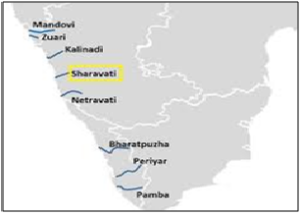
About Sharavathi Pumped Storage Hydroelectric Project:
- Location: It is a Pumped Storage Hydroelectric Project proposed on the Sharavathi River in Shivamogga district Karnataka.
- Electricity capacity: It is designed to generate 2,000 MW of electricity.
- Use of existing reservoirs: The project involves building a pumped storage power plant between two existing reservoirs, Talakalale Dam and Gerusoppa Dam. Water will be pumped uphill during off-peak hours and released downhill to generate electricity during peak demand.
- Based on Kaleshwaram project: It is modelled on the lines of Telangana’s Kaleshwaram project, it also aims to supply drinking water to Bengaluru.
- Concerns: The project falls within the Eco-Sensitive Zone (ESZ) of the Sharavathi Wildlife Sanctuary, which is home to the endangered lion-tailed macaque, hornbills, king cobras, and numerous endemic plant species of the Western Ghats.
About Sharavathi River:
- Location: It is a river in the western Karnataka state. A large part of the river basin lies in the Western Ghats.
- West-flowing river: It is one of the few rivers in India, which flows in the west direction.
- Course: Rising in the Western Ghats, it flows in a northwesterly direction and empties into the Arabian Sea at Honnavar near the Uttara Kannada district.
- Total Length: The river is approximately 128 km long.
- Area: The river basin covers 2,985 sq.km.
- Jog falls: On its way, the Sharavathi forms the Jog Falls, one of the highest waterfalls in India, where the river falls from a height of 253 m. Diverse geological features mark the river’s course, including rocky outcrops, fertile plains, and deep gorges.
- Major Tributaries: Major tributaries of the river includes Nandihole, Haridravathi, Mavinahole, Hilkunji, Yennehole, Hurlihole, and Nagodihole.
Source:
(MAINS Focus)
(UPSC GS Paper III – Security Challenges and their Management in Border Areas; Linkages of Organized Crime with Terrorism)
Context (Introduction)
The blast near Delhi’s Red Fort on November 10, killing 13 people, once again exposes India’s vulnerability to terrorism. Beyond policing, it calls for a broader counterterrorism framework centred on social harmony, political restraint, and state legitimacy.
Main Arguments Put Forward
- Evolving Nature of Terror Threats: The explosion marks a concerning shift, as organised terror incidents had largely been confined to conflict zones. Attacks targeting the national capital signal renewed efforts to destabilise peace and erode citizens’ sense of security.
- Strengthened Legal and Institutional Mechanisms: The use of the Unlawful Activities (Prevention) Act (UAPA) and the Explosives Act, and the involvement of the National Investigation Agency (NIA), demonstrate India’s strengthened legal and institutional framework to combat terrorism.
- Preventive Intelligence and Coordination: Effective intelligence gathering has thwarted multiple potential attacks, including a possible chemical strike. The success of counterterrorism often lies in preventing unseen incidents through inter-agency coordination and real-time data sharing.
- Necessity of Political and Media Responsibility: Political rhetoric and speculative media coverage can intensify communal polarisation, which inadvertently furthers terrorist objectives. A responsible approach from all stakeholders is essential to preserve public calm and faith in institutions.
- Social Harmony as Core of Counterterrorism: Terrorist groups exploit divisions and alienation. Hence, national security must integrate deradicalisation, interfaith dialogue, inclusive governance, and community engagement to prevent recruitment and reinforce democratic legitimacy.
Criticisms / Drawbacks Highlighted
- Overreach of Security Laws: Stringent provisions of UAPA, such as prolonged detention and limited bail, often attract criticism for infringing on civil liberties.
- Excessive Securitisation: Overdependence on force without addressing social roots of radicalisation can alienate communities.
- Lack of Community-Centric Approach: Counterterrorism remains overly institutional, with minimal grassroots involvement or rehabilitation mechanisms.
- Media Sensationalism: Irresponsible reporting amplifies panic and inadvertently spreads fear.
- Political Exploitation: Politicisation of terror incidents weakens national unity and diverts attention from policy-based solutions.
Reforms Mentioned / Suggested
- Integrated Counterterrorism Framework: Adopt a comprehensive model linking intelligence, policing, judiciary, and community-based prevention mechanisms.
- Deradicalisation and Rehabilitation Programmes: Scale up models from States like Kerala and Maharashtra focusing on counselling, education, and online radicalisation monitoring.
- Police and Forensic Modernisation: Strengthen the Modernisation of Police Forces (MPF) Scheme for technological upgradation and faster investigations.
- Judicial Oversight and Transparency: Establish independent review mechanisms for UAPA cases to prevent misuse and expedite trials.
- Promotion of Social Cohesion: Institutionalise inter-community peace committees, local outreach campaigns, and civic education initiatives to reinforce unity and resilience.
Conclusion
Terrorism thrives on fear and division; the most effective counter is unity and trust. A mature democracy like India must balance strong security measures with compassion and inclusivity. By integrating social harmony into counterterrorism policy, the state strengthens both its legitimacy and citizens’ faith in justice.
Mains Question
Terrorism aims to instigate fear and division within society. In this context, discuss how promoting social harmony and inclusivity can serve as an integral component of India’s counterterrorism strategy. (15 marks, 250 words)
Source: The Hindu
(UPSC GS Paper III – Science and Technology: Developments and their Applications; Government Policies and Interventions for Development in various Sectors and Issues arising out of their Design and Implementation)
Context (Introduction)
The Ministry of Electronics and Information Technology (MeitY) has released governance guidelines for Artificial Intelligence (AI) under the guiding principle of “Do No Harm.” These aim to balance innovation and accountability through risk-based regulation and adaptive frameworks.
Main Arguments Put Forward
- Balanced and Adaptive Regulatory Approach: The government has chosen a “light-touch” regulatory stance to foster innovation while addressing AI’s ethical and security risks. Rather than enacting a separate AI law, the framework leverages existing acts like the IT Actand Digital Personal Data Protection Act.
- Six-Pillar Governance Framework: The guidelines are structured around infrastructure, capacity building, policy and regulation, risk mitigation, accountability, and institutions. This holistic approach integrates AI development with the country’s Digital Public Infrastructure (Aadhaar, UPI) and economic strategy.
- Focus on Risk Mitigation and Accountability: An India-specific risk assessment model will evaluate AI’s sectoral impact. A graded liability regime links accountability to function and risk level. The creation of an AI Incident Database and self-certification systems aim to ensure transparency and user protection.
- Institutional Mechanism for AI Governance: The framework envisions a multi-tiered structure: an AI Governance Group (AIGG) for oversight, a Technology and Policy Expert Committee (TPEC) for policy alignment, and an AI Safety Institute (AISI) for technical audits and compliance.
- Human-Centric and Inclusive Development: Emphasising AI for all, the guidelines call for skilling programs, AI literacy among citizens, and targeted support for MSMEs through tax rebates and AI-linked loans. The goal is to ensure equitable access and prevent digital divides in the AI ecosystem.
Criticisms / Drawbacks Highlighted
- Absence of Dedicated AI Law: Critics argue that relying on existing frameworks may delay the establishment of clear liability, data usage norms, and safeguards against AI misuse.
- Risk of State Surveillance: Integration of AI into public infrastructure could raise privacy and autonomy concerns without robust data protection enforcement.
- Weak Oversight on Deepfakes: Although the content authentication proposal is welcome, the lack of a strong enforcement mechanism against non-compliance may undermine effectiveness.
- Government Use of Foreign AI Systems: Concerns persist about sensitive official data being processed by global AI models, risking strategic inference and data leakage.
- Voluntary Compliance Model: Heavy dependence on self-regulation and voluntary frameworks could limit accountability, especially among private players.
Reforms Mentioned / Suggested
- Techno-Legal Safeguards: Embed privacy, fairness, and transparency principles directly into AI system design—promoting ethical-by-design development.
- AI Content Labelling: Amend IT Rules to mandate disclosure of synthetically generated content, requiring platforms to display visible labels on deepfakes and AI-created media.
- Capacity and Skill Building: Strengthen AI training for citizens, public servants, and law enforcement to improve literacy and responsible usage.
- Public–Private Collaboration: Encourage joint AI innovation sandboxes and cross-sector partnerships to align industrial growth with ethical standards.
- International Cooperation: Participate in global forums on AI standards and ethics to harmonise India’s regulatory stance with global best practices.
Conclusion
India’s AI guidelines mark a pragmatic step toward responsible innovation — balancing the promise of AI-driven growth with the risks of misuse. By emphasising “Do No Harm,” promoting human-centric values, and integrating AI into governance cautiously, India aims to position itself as a global model for ethical, inclusive, and innovation-friendly AI regulation.
Mains Question
“India’s new AI governance framework seeks to balance innovation with accountability.” Critically analyse this approach in light of ethical, legal, and institutional challenges associated with emerging technologies. (15 marks, 250 words)
Source: The Indian Express

